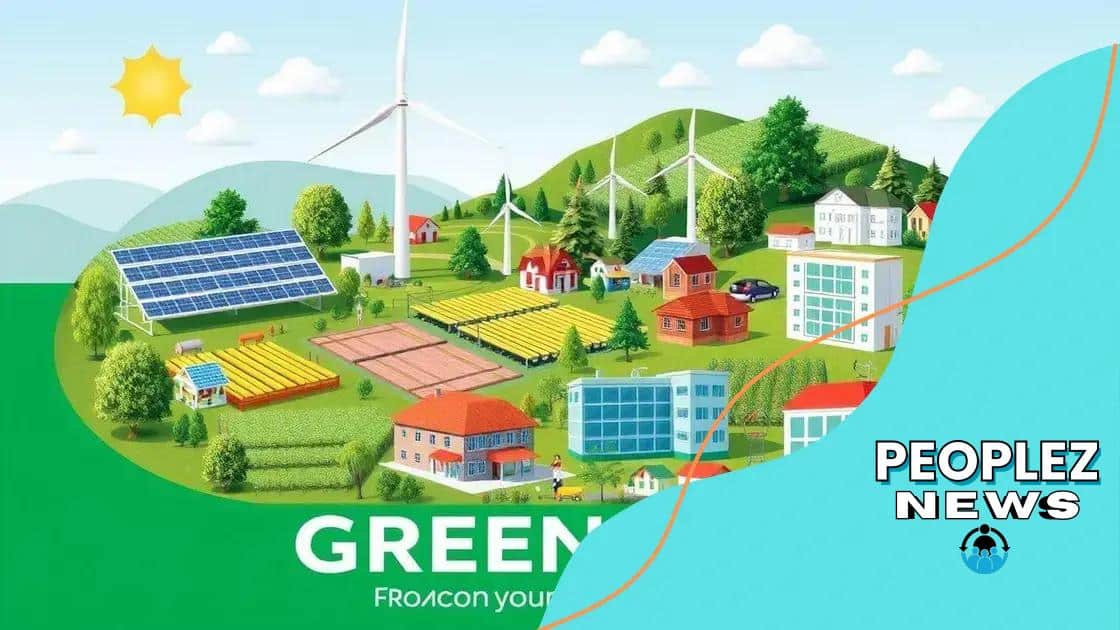Green bonds and their environmental impact explained

Green bonds are financial instruments that fund environmentally beneficial projects, such as renewable energy and energy efficiency, playing a crucial role in promoting sustainability and combating climate change.
Green bonds and their environmental impact are becoming increasingly important in the fight against climate change. Have you ever wondered how these financial instruments can help protect our planet? Let’s dive into this fascinating topic.
Understanding green bonds: A primer
Understanding green bonds is essential for anyone interested in sustainable investment. These financial instruments are designed specifically to fund projects that have positive environmental impacts. Each green bond provides investors an opportunity to support eco-friendly initiatives while earning a return on their investment.
The market for green bonds has grown rapidly in recent years, reflecting increasing interest from both investors and issuers. Companies, municipalities, and governments are keen to use green bonds as a way to finance renewable energy projects, energy-efficient buildings, and sustainable infrastructure.
What makes green bonds unique?
Green bonds differ from traditional bonds in several significant ways:
- Funds are exclusively used for environmental projects.
- They often include specific reporting requirements on the environmental impact.
- They can attract a broader base of socially conscious investors.
Investors are increasingly looking to invest their money in ways that align with their values. This trend is leading to greater participation in the green bond market. Not only does this help the environment, but it also encourages companies to prioritize sustainability in their operations.
How do green bonds work?
When an organization issues a green bond, they receive money from investors, which they then use to fund environmentally friendly projects. These projects often aim to reduce greenhouse gas emissions or improve energy efficiency. After the projects generate returns, the issuer pays back the investors at the bond’s maturity.
The benefits of investing in green bonds extend beyond the financial realm. By supporting sustainable projects, investors can play a vital role in fighting climate change, making a tangible difference in the world.
With the increasing popularity of green bonds, it’s crucial for investors to understand their potential impact and the opportunities they present. As more funding flows into sustainable projects, it creates a chance for a greener future for generations to come.
The role of green bonds in sustainable finance
The role of green bonds in sustainable finance is becoming increasingly vital as the world grapples with climate change and environmental degradation. These bonds serve as funding tools for projects aimed at achieving environmental benefits, making them essential in the shift toward a sustainable economy.
Investors are taking notice of how green bonds can contribute to societal benefits while also delivering financial returns. By investing in these bonds, individuals and institutions can support initiatives such as renewable energy, sustainable agriculture, and energy efficiency upgrades.
How green bonds drive sustainable finance
Green bonds have a unique position in the landscape of sustainable finance. They create new capital for projects that impact the environment positively. Some examples of projects financed by these bonds include:
- Solar and wind energy installations.
- Retrofitting buildings for energy efficiency.
- Water management and conservation initiatives.
This type of financing allows various sectors to align their financial strategies with broader sustainability goals. Consequently, the growth of the green bond market encourages more organizations to adopt environmentally friendly practices and report on their sustainability objectives.
The benefits of investing in green bonds
Investing in green bonds offers several advantages beyond just environmental impact. For example, they can provide:
- Portfolio diversification through socially responsible investments.
- Attractively fixed returns that are often competitive.
- A sense of contributing to global sustainability.
As more investors become aware of the benefits, the demand for green bonds continues to rise. This trend is creating a ripple effect throughout the financial markets, pushing more entities to consider the environmental implications of their projects.
Ultimately, the role of green bonds in sustainable finance is crucial. They not only provide a pathway to funding necessary ecological projects but also create a culture of accountability in corporate governance regarding environmental risks and impacts.
Key projects funded by green bonds

Key projects funded by green bonds represent significant steps towards a sustainable future. These bonds have been used to finance a variety of initiatives that aim to reduce carbon emissions and promote environmental health. Understanding these projects helps investors see the tangible impacts of their investments.
One major area of funding is renewable energy. Many green bonds support wind and solar energy projects that contribute to cleaner power generation. For example, large wind farms are developed to harness natural wind energy, generating electricity with minimal environmental impact.
Examples of funded projects
Here are several types of projects that benefit from green bonds:
- Solar farms that provide clean energy to local communities.
- Upgrades to public transportation systems to increase efficiency and reduce emissions.
- Energy-efficient building developments that minimize resource use.
- Water conservation projects aimed at improving local ecosystems.
Another key area is energy efficiency improvements in existing infrastructure. Funds generated from green bonds can be used to retrofit buildings, making them more energy-efficient. This not only reduces operational costs but also lowers the carbon footprint of those buildings.
Additionally, some green bonds support sustainable agriculture practices. Initiatives like this may include funding for organic farming techniques or projects that focus on water conservation in farming operations. These projects help ensure a sustainable food supply while minimizing environmental impact.
As more organizations tap into the green bond market, the variety and scope of funded projects continue to expand. This diversification enables a collective impact across multiple sectors, driving forward the global transition to sustainability.
Challenges associated with green bonds
Challenges associated with green bonds can pose obstacles to their effectiveness and widespread adoption. While these financial instruments present numerous benefits, it is essential to understand the potential issues that can arise. A deeper awareness of these challenges can help investors and issuers navigate the green bond market more effectively.
One significant challenge is the inconsistency in definitions and standards. Different organizations may have varying criteria for what qualifies as a green bond. This lack of uniformity can lead to confusion among investors and reduce the perceived value of these bonds.
Key obstacles in the green bond market
Several challenges exist that can impede the growth of the green bond market:
- Transparency issues: Investors may struggle to find relevant information about the ecological impact of projects financed by green bonds.
- Limited project pipeline: There may be insufficient quality projects available to attract the needed capital.
- Market maturity: The green bond market is still relatively young, which may deter conservative investors.
Moreover, the verification process for green bond projects can be complex. Third-party evaluations are often necessary to confirm that the funded projects genuinely deliver environmental benefits. This evaluation can be costly and time-consuming, which may discourage some issuers.
Additionally, some investors question the long-term financial viability of projects funded by green bonds. They seek assurance that their investments will yield favorable returns alongside environmental impacts. These concerns highlight the importance of project planning, management, and reporting to foster confidence among investors.
Despite these challenges, the green bond market is evolving. Increased awareness of sustainability and continued financial innovation will likely address many of these concerns over time. Enhanced standards, improved reporting practices, and better project pipelines can help pave the way for a successful future in green bonds.
Future trends in green bond markets
Future trends in green bond markets indicate a growing shift toward sustainability in finance. As environmental concerns become more pressing, the demand for green financing is expected to surge. This transformation will shape the financial landscape in the coming years.
A significant trend is the increasing standardization of what qualifies as a green bond. As more guidelines and frameworks emerge, investors will gain clearer insight into the environmental impacts of their investments. This enhanced transparency will attract more capital from diverse sources.
Emerging trends to watch
Several emerging trends in the green bond market are noteworthy:
- Increased corporate participation: More companies are issuing green bonds to finance their sustainability initiatives.
- Integration of ESG factors: Environmental, social, and governance (ESG) criteria will become integral to bond assessments.
- Technological advancements: Innovations in tracking and reporting the impacts of funded projects will improve accountability.
As green bonds evolve, they may also attract younger investors who prioritize sustainability. This demographic shift is likely to drive demand for green investment options, ultimately leading to the growth of the market.
Moreover, regional developments will play a vital role. Emerging markets are increasingly exploring green bond issuance as a means to finance sustainable projects. By tapping into this potential, these markets can not only secure funding but also address critical environmental challenges.
Collaboration between governments, financial institutions, and corporations will further enhance the green bond landscape. Joint efforts to create public-private partnerships can lead to large-scale projects that bridge funding gaps and foster sustainability on a grander scale. With these collaborative strategies, the future of green bonds looks promising as they become an essential tool in the transition to a more sustainable economy.
FAQ – Frequently Asked Questions about Green Bonds
What are green bonds?
Green bonds are financial instruments used to raise funds for projects that have positive environmental impacts.
How do green bonds benefit the environment?
They finance initiatives like renewable energy, energy efficiency improvements, and sustainable agriculture, contributing to a healthier planet.
What challenges exist in the green bond market?
Challenges include inconsistent standards, transparency issues, and the verification process for funded projects.
What trends are shaping the future of green bonds?
Trends include increased corporate participation, the standardization of criteria, and growing interest from younger investors focused on sustainability.





